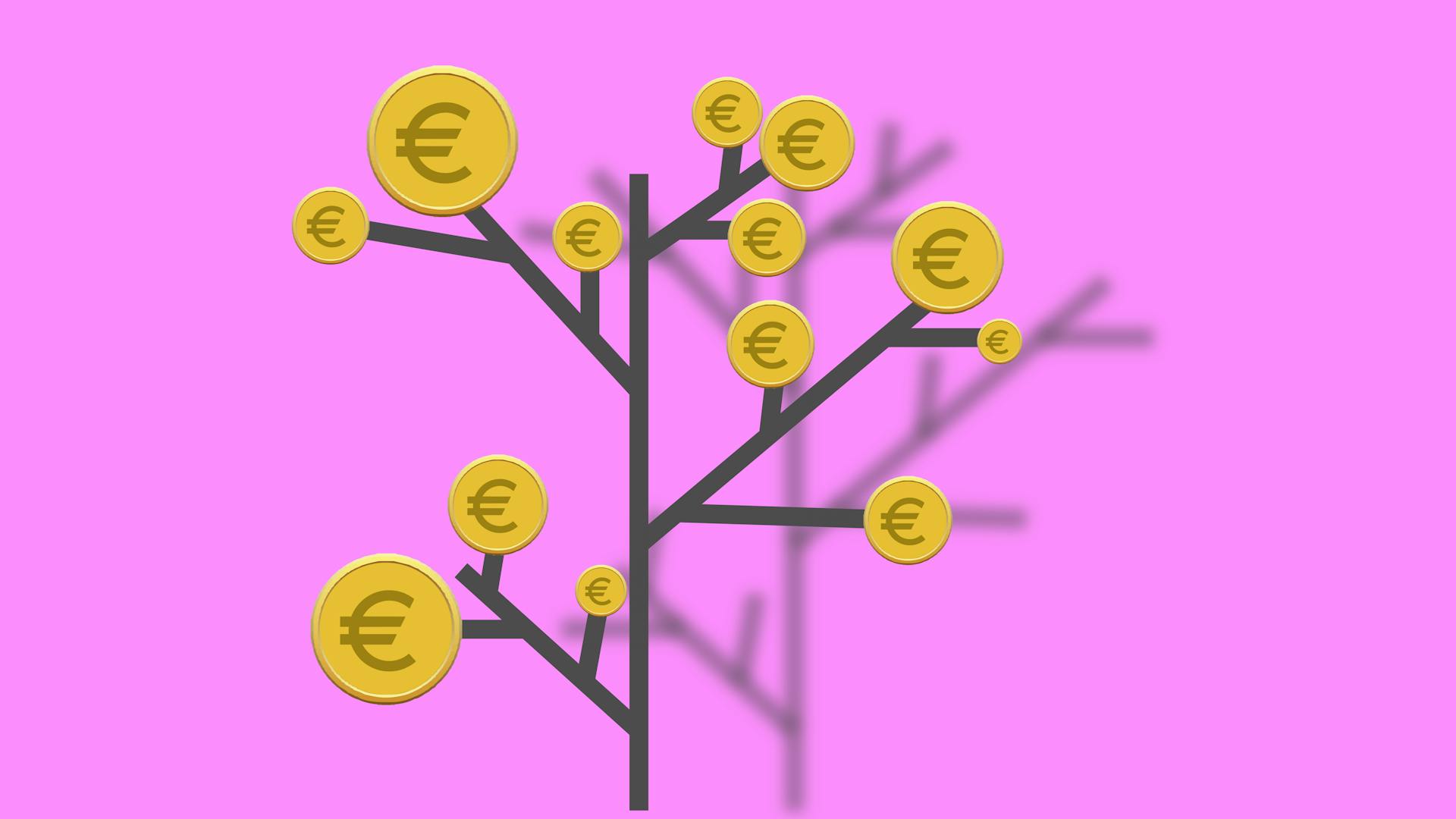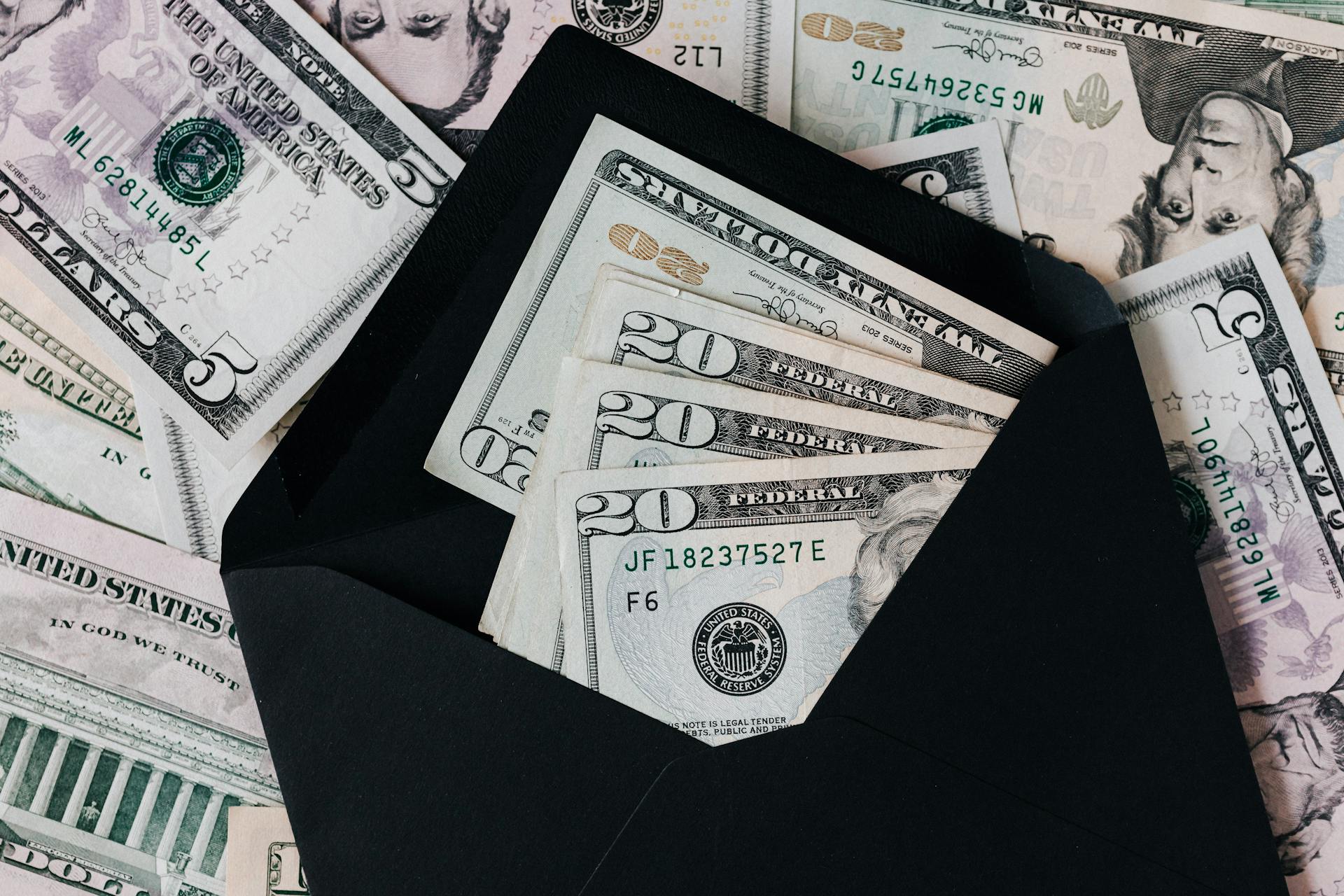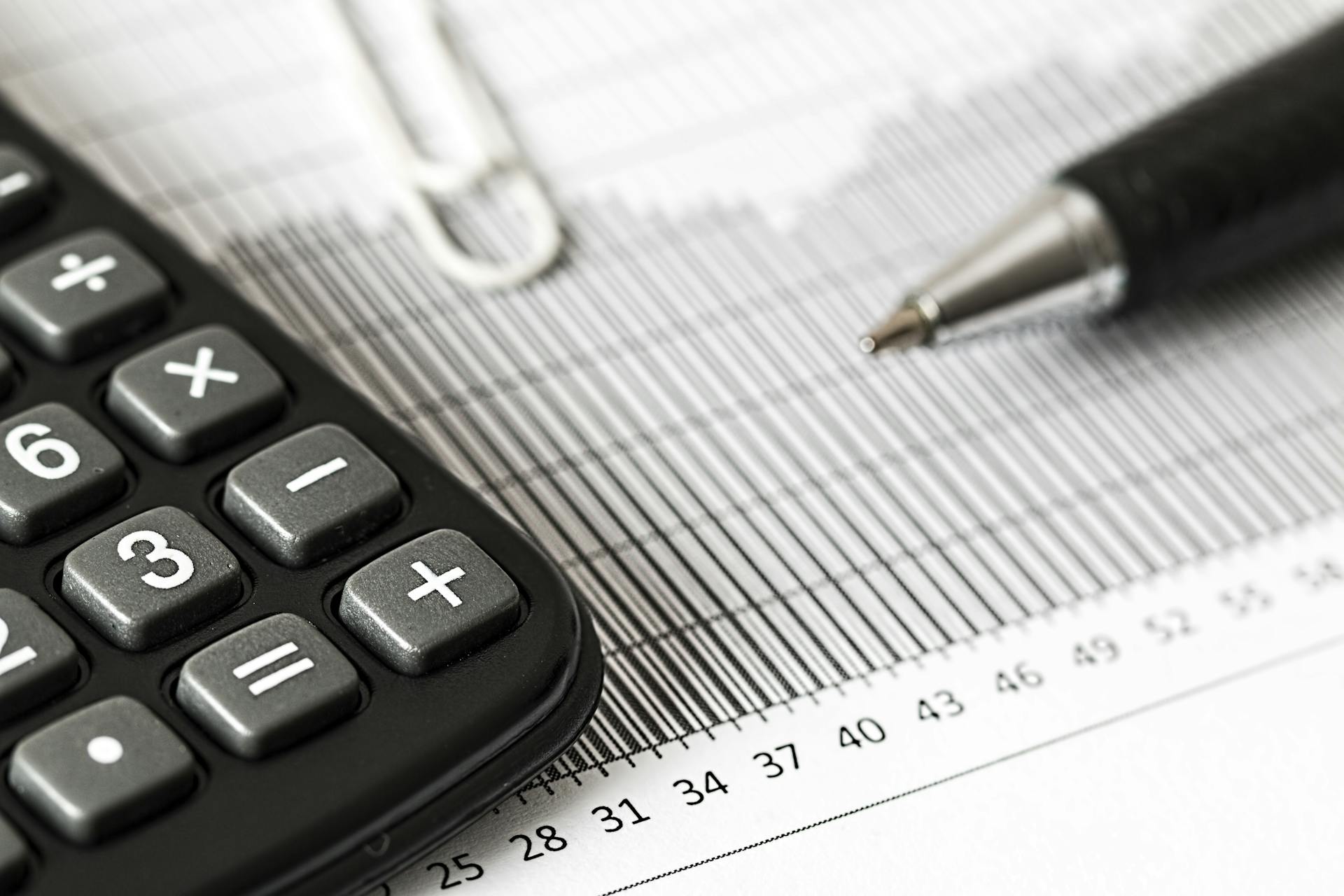
Compound interest is a powerful tool for growing your savings over time. It's calculated using the formula A = P(1 + r/n)^(nt), where A is the future value, P is the principal amount, r is the annual interest rate, n is the number of times interest is compounded per year, and t is the time in years.
The formula works by taking the principal amount and adding the interest earned each year, which is then used to calculate the interest for the next year. This creates a snowball effect, where the interest earns interest, resulting in exponential growth.
To illustrate this, let's consider an example. If you deposit $1,000 into a savings account with an annual interest rate of 5% compounded annually, the future value after 5 years would be $1,276.78. This is calculated using the formula A = 1000(1 + 0.05/1)^(1*5).
What Is Compound Interest?
Compound interest is the interest paid on both principal and existing interest, making it grow faster over time. It's calculated at regular intervals like annually, semi-annually, quarterly, or monthly, and interest income makes the money grow even faster.

The interest is calculated on the principal and existing interest, resulting in a new principal for the next interval. This is exactly what happens when compound interest is applied to an investment.
Banks and financial organizations use compound interest to calculate the amount of interest earned, and it's what makes money grow exponentially over time.
History
Compound interest has a rich history that spans centuries. The concept of compound interest was once considered a form of usury and was heavily criticized by Roman law and other countries' common laws.
The first recorded use of compound interest tables was by Francesco Balducci Pegolotti in his book Pratica della mercatura around 1340. He provided a table of interest on 100 lire for rates from 1% to 8% for up to 20 years.
The Rule of 72, which states that to find the number of years for an investment at compound interest to double, one should divide the interest rate into 72, was discovered by Luca Pacioli in his book Summa de arithmetica in 1494.
Richard Witt's book Arithmeticall Questions, published in 1613, was a significant contribution to the history of compound interest. It provided tables based on 10% and other rates for various purposes, including the valuation of property leases.
Jacob Bernoulli discovered the constant e in 1683 while studying a question about compound interest.
What Is?
Compound interest is the interest paid on both principal and existing interest. It's usually termed "interest over the interest" because it's calculated on top of the interest that's already been accumulated.
The interest is calculated at regular intervals, such as annually, semi-annually, quarterly, or monthly. This frequency can significantly impact how quickly your money grows.
The resulting amount, which includes the principal and the accumulated interest, becomes the new principal for the next interval. This process continues, making your money grow faster over time.
Interest income from an investment makes the money grow faster over time, and it's exactly what compound interest does to money.
Calculating Compound Interest
Calculating compound interest is a straightforward process that involves a few key variables: the principal amount, the interest rate, and the compounding frequency. The total compound interest generated is the final amount minus the initial principal, since the final amount is equal to principal plus interest.
The formula for compound interest is A = P (1 + r), where A is the total amount, P is the principal amount, and r is the interest rate. For example, if you invest $1,000 at a 4% interest rate compounded annually, the total amount after 3 years would be $1,124.86.
The compounding frequency, or how often the interest is capitalized, can also affect the total amount. For instance, if the interest is compounded monthly, the formula becomes A = P (1 + r/12). This means that the interest is applied 12 times a year, rather than just once.
Here's a table summarizing the different compounding frequencies and their corresponding formulas:
To find just the compound interest, you would subtract the principal amount from the total amount. For example, if the total amount is $1,124.86 and the principal amount is $1,000, the compound interest would be $124.86.
Calculation

Calculating compound interest is a straightforward process. The total compound interest generated is the final amount minus the initial principal, since the final amount is equal to principal plus interest.
To calculate compound interest, you need to know the principal amount, the interest rate, and the time period. For example, if you invest $1,000 at a 4% interest rate for 3 years, the final amount will be $1,124.86.
The formula to calculate compound interest is not explicitly stated in the article, but it can be inferred from Example 1. The final amount is equal to the principal plus interest, which is the result of multiplying the principal by the number of times interest is compounded.
Here's a simple formula to calculate compound interest: A = P(1 + r)^t, where A is the final amount, P is the principal, r is the interest rate, and t is the time period.
For example, if you invest $1,000 at a 4% interest rate for 3 years, the final amount will be $1,124.86.
Periodic

Periodic compounding is a key concept in calculating compound interest. The frequency of compounding can be yearly, half-yearly, quarterly, monthly, weekly, daily, or even continuously.
The formula for periodic compounding is A = P(1 + r/n)^(nt), where A is the final amount, P is the original principal sum, r is the nominal annual interest rate, n is the compounding frequency, and t is the overall length of time the interest is applied.
For example, if Cody invests $7,500 in an account that earns 4.5% interest compounded quarterly, after 10 years, his investment will be worth $11,732.82.
The compounding frequency can be adjusted to fit different time periods, such as annually, semi-annually, quarterly, monthly, weekly, or daily. Here's a table showing the formulas for different compounding frequencies:
For instance, if Abena invests $1,000 in a CD earning 4% compounded annually, after 3 years, her CD will be worth $1,124.86.
The effective annual yield can also be calculated using the periodic compounding formula. For example, if an investment pays a rate of 6% compounded quarterly, the effective annual yield is 6.14%.
Formulas and Rates
Compound interest is a powerful investment tool that can help your money grow over time. The compound interest formula is derived from the simple interest formula, where the principal is constant over a period of time.
The compound interest formula is P (1 + R/100), where P is the principal, R is the rate of interest, and the interest is compounded annually. However, this formula can be simplified to P (1 + r) by converting the rate to decimals. The rate of interest is usually expressed as a percentage, but for calculations, it's more convenient to use decimals.
To calculate the effective annual yield, you can use the formula Y=(1+rn)n-1, where Y is the effective annual yield, r is the interest rate in decimal form, and n is the number of times the interest is compounded in a year. This formula allows you to compare different compound interest situations and identify the best investment from a yield perspective.

The frequency of compounding can greatly impact the effective annual yield. For example, an investment paying a 6% interest compounded quarterly has an effective annual yield of 6.14%, while the same investment compounded daily has an effective annual yield of 5.13%.
Here's a summary of the formulas for calculating compound interest:
Note that the formulas assume annual compounding, but you can adjust the frequency of compounding to suit your needs.
Computing Present and Future Values
The present value formula is used to determine how much money needs to be invested now to reach a future goal. For example, to reach a final account value of $250,000 invested at 6.75% interest compounded monthly for 30 years, $33,186.23 needs to be invested.
To calculate present value, the formula is PV=A(1+rn)n×t, where PV is the present value, A is the future value, r is the interest rate in decimal form, n is the number of times interest is compounded per year, and t is the time in years. This formula is used to find the present value of an investment.
The future value formula is used to determine the value of an investment after a certain period of time. For example, the future value of $5,000 invested at 3.8% interest compounded monthly for 5 years is $6,044.43.
Here are some examples of present and future values:
Computing Future
Computing Future Value for Compound Interest is a crucial concept to understand when investing in accounts bearing compound interest. The formula to find the future value of an investment is A=P(1+rn)nt, where A is the future value, P is the principal amount, r is the annual interest rate in decimal form, n is the number of times interest is compounded per year, and t is the time in years.
The future value of an investment is the total amount of money the investment will be worth after a certain period of time. This can be calculated using the formula A=P(1+rn)nt. For example, if you invest $5,000 at an annual interest rate of 3.8%, compounded monthly, for 5 years, the future value of the investment is $6,044.43.
You can also use this formula to calculate the future value of an investment with a different compounding frequency. For instance, if you invest $18,500 at an annual interest rate of 6.25%, compounded quarterly, for 17 years, the future value of the investment is $53,093.54.
Here are some examples of calculating future value:
Remember, the future value of an investment is a crucial concept to understand when making investment decisions. By using the formula A=P(1+rn)nt, you can calculate the total amount of money your investment will be worth after a certain period of time.
Exact Monthly Payment
The exact formula for the monthly payment is surprisingly straightforward. It's given by the equation c = rP / (1 - (1 + r)^(-n)), where c is the monthly payment, r is the monthly interest rate, P is the principal, and n is the number of payment periods.
In spreadsheets, the PMT() function is used to calculate the monthly payment. The syntax is a bit more complex, but essentially it's a way to plug in the values and get the answer quickly.
There are two equivalent forms of the formula, which can be useful for different situations. One form is c = rP / (1 - (1 + r)^(-n)), while the other is c = rP / (1 - e^(-n * ln(1 + r))). Both will give you the same result, but one might be easier to work with depending on your specific needs.
For example, if you're trying to calculate the monthly payment on a loan, you would use the PMT() function in a spreadsheet or plug the values into one of these formulas.
Solved Examples and Practice
Compound interest can be a powerful tool for growing your savings, but it can also be a bit tricky to understand. The key is to know how it works and how to calculate it.
Let's take a look at some examples to see how compound interest can add up over time. For instance, in Example 1, Noah lends $4000 to Emma at an interest rate of 10% per annum, compounded half-yearly for a period of 2 years. The total interest to be paid over 2 years is a staggering $862.03.

The compound interest formula can make the solution simple, as seen in Example 2. By plugging in the values, we get A = P (1 + r/2) = $4862.03, which matches the answer we got in Example 1.
If you're looking to double your investment, the rule of 72 can be a helpful tool. As seen in Example 3, using the rule of 72, the doubling time is approximately 24 years, which matches the answer we got using the compound interest formula.
Here's a quick breakdown of the examples we've looked at:
Remember, the key to making compound interest work for you is to start early and be patient. With time, your savings can grow exponentially, helping you achieve your financial goals.
Variables and Investments
Variables and investments are the foundation of any financial plan.
There are four crucial elements that make up any typical financial investment: Return rate, Starting amount, End amount, and Investment length. These variables are the building blocks of any investment, and understanding them is key to making informed decisions.

The Return rate is the percentage used to compare the attractiveness of various financial investments. It's the cold, hard number that investors look for. I recall a friend who was excited about a high-return investment, but it turned out to be riskier than expected.
The Starting amount, also known as the principal, is the amount visible at the inception of the investment. This can be a large sum saved up for a home, an inheritance, or the purchase price of a quantity of gold. For example, a person might invest $10,000 in a savings account.
Additional contributions, or annuity payments, can also impact the investment. These can be made during the life of the investment and result in a more accrued return and a higher end value.
Monthly Deposits
Making sense of monthly deposits can be a challenge, but don't worry, I've got you covered. The formula for compound interest gained per unit of time is M′=M(1+r)t, where M is the monthly deposit, r is the rate of return (monthly), and t is the time in months.

This formula is the key to understanding how your monthly deposits can grow over time. In fact, the total return of an investment can be calculated using this formula, along with the principal deposit and the rate of return. The formula is P′=M(1+r)t−−1r+P(1+r)t, where P is the principal deposit.
To calculate the compound interest for each deposit, you can use the formula M′=∑∑i=0t−−1M(1+r)t−−i. This formula takes into account all the recurring deposits over the total period t.
Here's a breakdown of the variables involved:
- P = principal deposit
- r = rate of return (monthly)
- M = monthly deposit
- t = time, in months
With these variables in mind, you can use the formula P′=M(1+r)t−−1r+P(1+r)t to calculate the total return of your investment. This formula is a game-changer for anyone looking to grow their savings over time.
Variables Involved
Investments involve a lot of variables, and understanding them is key to making informed decisions.
The return rate is a crucial element in any financial investment, and it's usually expressed as a percentage.

For many investors, the return rate is what matters most. It's the cold, hard number used to compare the attractiveness of various sorts of financial investments.
The starting amount, also known as the principal, is the amount apparent at the inception of the investment. This can be a large amount saved up for a home, an inheritance, or the purchase price of a quantity of gold.
The longer the investment, the riskier it becomes due to the unforeseeable future. Generally, the more periods involved in an investment, the more compounding of return is accrued and the greater the rewards.
Here are the four crucial elements that make up the investment:
- Return rate
- Starting amount (principal)
- End amount
- Investment length
Additional contributions, commonly referred to as annuity payments, can be made during the life of an investment. Any additional contributions will result in a more accrued return and a higher end value.
Choosing a Bank
Choosing a Bank can be a daunting task, especially when interest rates are involved.
To compare interest rates, Minh could change each rate to its effective annual yield, allowing for a direct comparison between the rates. Computing the effective annual yield gives a clearer picture of the true interest rate.
For example, ABC Bank's 2.08% monthly interest rate becomes 2.10% when calculated as an effective annual yield. This means that if you deposit $3,200 with ABC Bank, you can expect an interest rate of 2.10% per year.
The effective annual yield also helps to compare rates from banks with different compounding periods, such as 123 Bank's 2.09% annual interest rate and XYZ Bank's 2.05% daily interest rate.
Here's a comparison of the effective annual yields for each bank:
As you can see, ABC Bank offers the highest effective annual yield, making it the best choice for Minh if he wants to get the best interest.
Investment Goal
Pilar plans to retire comfortably at 67 with $1,500,000, so she needs to invest a significant amount at age 23 to reach this goal.
The interest rate on her account is 6.35%, which is 0.0635 in decimal form, and it's compounded monthly.
To calculate how much she needs to deposit, we use the formula for present value, taking into account that she'll leave the money in the account for 44 years.
Pilar will need to invest $92,442.51 in this account to have $1,500,000 at age 67.
If she wants to reach her goal in a shorter time frame, here's how her investment needs change:
- For 40 years, she'll need to invest more, but the exact amount isn't specified in this example.
- For 35 years, the investment requirement isn't mentioned.
- For 30 years, the investment amount isn't provided.
- For 25 years, Pilar will need to deposit a larger sum, but the exact amount is unknown.
- For 20 years, the investment requirement isn't specified.
- For 15 years, the investment amount isn't mentioned.
Sources
- https://en.wikipedia.org/wiki/Compound_interest
- https://www.cuemath.com/commercial-math/compound-interest/
- https://math.libretexts.org/Bookshelves/Applied_Mathematics/Contemporary_Mathematics_(OpenStax)/06%3A_Money_Management/6.04%3A__Compound_Interest
- https://openstax.org/books/contemporary-mathematics/pages/6-4-compound-interest
- https://www.calculator.net/investment-calculator.html
Featured Images: pexels.com


